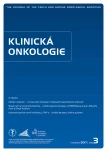Isolated Perfusion of the Upper Extremity with TNF-α – Double Venous Cannulation
Authors:
M. Špaček 1; P. Mitáš 1; M. Vočka 2; L. Lacina 3; G. Hodková 1; R. Špunda 1; O. Kodet 3; I. Krajsová 3; L. Petruželka 2; J. Trnka 4,5; J. Kubinyi 4; Z. Matějovský 6; L. Lambert 7; J. Lindner 1
Authors‘ workplace:
II. chirurgická klinika kardiovaskulární chirurgie 1. LF UK a VFN v Praze
1; Onkologická klinika 1. LF UK a VFN v Praze
2; Dermatovenerologická klinika 1. LF UK a VFN v Praze
3; Ústav nukleární medicíny, 1. LF UK a VFN v Praze
4; Oddělení radiační ochrany, VFN v Praze
5; Ortopedická klinika 1. LF UK a Nemocnice Na Bulovce, Praha
6; Radiodiagnostická klinika 1. LF UK a VFN v Praze
7
Published in:
Klin Onkol 2017; 30(3): 213-219
Category:
Case Report
doi:
https://doi.org/10.14735/amko2017213
Overview
Background:
The authors present a technical variation of the standard cannulation for cardiopulmonary bypass perfusion during hyperthermic isolated limb perfusion (ILP) procedures in selected patients with unresectable soft tissue sarcoma or malignant melanoma.
Patients:
Of 55 ILP procedures performed at our institution since the procedure was established in 2009, nine were performed at the upper extremity. Standard single venous cannulation was used in five cases, and extended, double venous cannulation in the last four. The standard technique for brachial vein cannulation in a small compartment of the upper extremity entails a problematic and longer perfusion of the upper extremity. This is due to the lower flow rate in the venous system and relatively large surface area with respect to weight. We present a simple technique based on a “Y” cannulation of the venous system via the deep brachial vein and superficial venous system via the basilic vein, delivering a 20% increase in flow rate in the extracorporeal circulation. Faster heating of the upper extremity and a stable thermal environment throughout upper-extremity ILP are essential for successful treatment.
Conclusion:
Extended technique of venous cannulation for extracorporeal circulation setting, due to their advantages, became standard in the upper limb ILP procedure at our institution.
Key words:
isolated limb perfusion – malignant melanoma – soft tissue sarcoma – upper limb – extracorporeal circulation
The authors declare they have no potential conflicts of interest concerning drugs, products, or services used in the study.
The Editorial Board declares that the manuscript met the ICMJE recommendation for biomedical papers.
Submitted:
8. 1. 2017
Accepted:
15. 1. 2017
Sources
1. Creech O, Krementz ET, Ryan RF et al. Chemotherapy of cancer: regional perfusion utilizing an extracorporeal circuit. Ann Surg 1958; 148 (4): 616–632.
2. Koops HS, Garbe C, Hohenberger P. Is isolated limb perfusion of metastatic malignant melanoma of the extremity worthwhile? Eur J Cancer 1996; 32A (10): 1633–1640.
3. Krementz ET, Carter RD, Sutherland CM et al. Regional chemotherapy for melanoma. A 35-year experience. Ann Surg 1994; 220 (4): 520–535.
4. Fraker DL, Alexander HR, Ross M et al. A phase III trial of isolated limb perfusion for extremity melanoma comparing melphalan alone versus melphalan plus tumor necrosis factor (TNF) plus interferon-gamma (IFN). Philadelphia: Lippincott Williams & Wilkins 2002: 8.
5. Eggermont AM, Schraffordt Koops H, Klausner JM et al. Isolated limb perfusion with tumor necrosis factor and melphalan for limb salvage in 186 patients with locally advanced soft tissue extremity sarcomas. The cumulative multicenter European experience. Ann Surg 1996; 224 (6): 756–765.
6. Špaček M, Petruželka L, Lacina L et al. Tasonermin jako součást izolované perfuze končetin. [online]. Farmakoterapie 2011; 5. Dostupné z: http: //www.prolekare.cz/farmakoterapie-clanek/tasonermin-jako-soucast-izolovane-perfuze-koncetin-36816.
7. Taeger G, Grabellus F, Podleska LE et al. Effectiveness of regional chemotherapy with TNF-alpha/melphalan in advanced soft tissue sarcoma of the extremities. Int J Hyperthermia 2008; 24 (3): 193–203. doi: 10.1080/02656730701868387.
8. Moreno-Ramirez D, de la Cruz-Merino L, Ferrandiz L et al. Isolated limb perfusion for malignant melanoma: systematic review on effectiveness and safety. Oncologist 2010; 15 (4): 416–427. doi: 10.1634/theoncologist.2009-0325.
9. Dranoff G. Cytokines in cancer pathogenesis and cancer therapy. Nat Rev Cancer 2004; 4 (1): 11–22.
10. Wu Y, Zhou BP. TNF-alpha/NF-kappaB/Snail pathway in cancer cell migration and invasion. Br J Cancer 2010; 102 (4): 639–644. doi: 10.1038/sj.bjc.6605 530.
11. Trnka J, Špaček M, Šírová V et al. Hypertermická izolovaná perfuze končetin v kombinaci s tasonerminem – technika monitorování úniku perfuzátu. Klin Onkol 2016; 29 (5): 375–379. doi: 10.14735/amko2016 375.
12. Kroon HM, Moncrieff M, Kam PC et al. Outcomes following isolated limb infusion for melanoma. A 14-year experience. Ann Surg Oncol 2008; 15 (11): 3003–3013. doi: 10.1245/s10434-008-9954-6.
Labels
Paediatric clinical oncology Surgery Clinical oncologyArticle was published in
Clinical Oncology

2017 Issue 3
- Metamizole vs. Tramadol in Postoperative Analgesia
- Metamizole at a Glance and in Practice – Effective Non-Opioid Analgesic for All Ages
- Spasmolytic Effect of Metamizole
- The Importance of Hydration in Wound Healing
- Obstacle Called Vasospasm: Which Solution Is Most Effective in Microsurgery and How to Pharmacologically Assist It?
Most read in this issue
- Recent Overview of Kidney Cancer Diagnostics and Treatment
- SAMPUS, MELTUMP and THIMUMP – Diagnostic Categories Characterized by Uncertain Biological Behavior
- Malignant Melanoma – from Classical Histology towards Molecular Genetic Testing
- Breast Cancer in Young Women – Correlation of Clinical Histomorphological, and Molecular-genetic Features of Breast Carcinoma in Women Younger than 35 Years of Age
